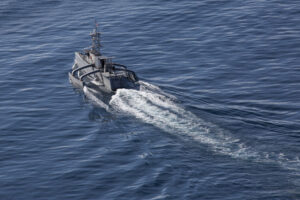Naval Sea Systems Command (NAVSEA) awarded Sigma Defense’s SOLUTE a $19 million contract to provide integration for autonomy software for the Navy’s unmanned vehicles via the Autonomy Baseline Manager (ABM).
The company said its work will provide integration services for autonomy software for the unmanned vehicles falling under program Executive Office Unmanned Small Combatants (PEO USC).
The contract has a single base year and four option years. If all options are exercised, the value would rise to a total of $59 million and be completed in February 2029.
The company said in a statement that it will leverage its experience in DevSecOps to “deliver tools and processes to manage pipelines and integrate autonomous capabilities among Unmanned Vehicles (UxVs).”
It will specifically use DevSecOps and Agile methodologies using the Rapid Autonomy Integration Lab (RAIL) process, which includes a software factory for Continuous Integration and Continuous Delivery (CI/CD) of software to UxVs.
DevSecOps is an application development practice that looks to include security into software early in development.
Navy officials unveiled the RAIL in 2020 with the aim to help test and integrate new and updated autonomy capabilities in various unmanned surface vessels and unmanned undersea vehicles (Defense Daily, Sept. 8, 2020).
The company told Defense Daily in a statement that this work means it will not be developing autonomous behavior systems themselves, but support the program office and vendors that do.
“For instance, a small company that develops an Autonomous Systems algorithm will have a place to upload their code, compile, debug and deploy into a common hosting environment. This will propel that codebase a long way toward an accreditation and ensure interoperability with other autonomy systems.”
Sigma Defense said it will help the program office achieve its objective if there are compatibility issues between companies and autonomy systems while allowing the original equipment manufacturers to maintain their proprietary systems.
The company also told Defense Daily that while the Navy has to choose the best of breed autonomous systems that align to the surface, sub-surface, and aerial mission sets, it is unlikely any single autonomous system will best fit each mission set, so multiple systems have to be able to communicate, which Sigma will help facilitate.
“Where appropriate these autonomy systems must talk to one another and pass relevant data. For Sigma Defense, this fits globally into our thesis of any data anywhere anytime and this win offers the ability to support that within the Navy Unmanned fleet,” it said.

Ed Anderson, executive vice president at Sigma Defense, argued that Sigma Defense “has a long history of successfully delivering DevSecOps capabilities to the U.S. Navy through our work on Black Pearl, The FORGE, and the Rapid Autonomy Integration Lab (RAIL). We are pleased to build on that success and deliver new tools, processes, and integration expertise to bring new capabilities to PMS 406 [Unmanned Maritime Systems program office].”
The company noted while none of its products will be maintained within the RAIL, it will be based upon the Black Pearl ecosystem.
Black Pearl is a Navy-launched group of defense, business, government and academia personnel who provide a platform that unifies and streamlines software development across the DoD enterprise to accelerate software application deployment at a lower cost.
The company also told Defense Daily that ABM gives them the ability to demonstrate how effective it is to develop and deliver software in the Black Pearl DevSecOps environment.
It called Black Pearl an “integral part of our larger CJADC2 strategy, which will provide both the development environment and a deployment platform so that the OEMs can build/modify/develop within ABM/RAIL ecosystem then deploy into an identical software environment on the hardware of their choosing.”
While Sigma Defense is supporting the Navy program office via this contract, it told Defense Daily it hopes to build on this in the future to similarly support other DoD and government agencies by hosting their autonomous systems in a similar way so they can also talk to each other.
